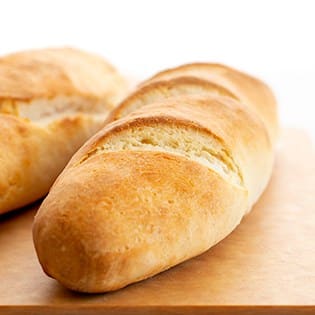

This recipe for gluten free French bread rises fast and bakes even faster. It makes the perfect gluten free baguette for sandwiches, garlic bread, and bruschetta.
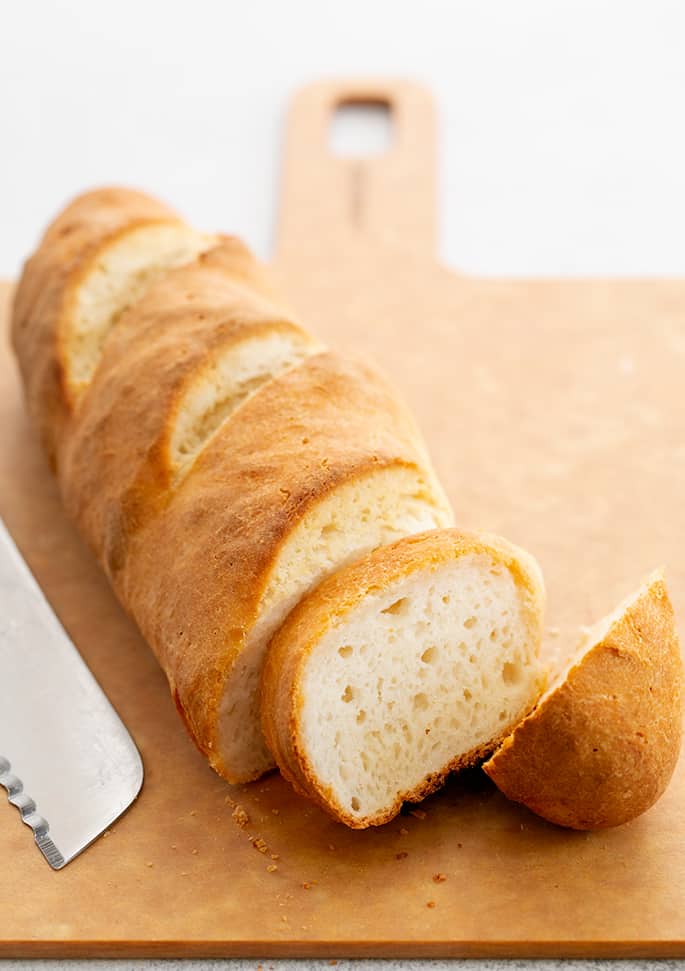
WANT TO SAVE THIS RECIPE?
What makes this gluten free French bread recipe special
These gluten free baguettes have a thin, crisp outside crust and a soft, almost squishy inside. They're as quick and easy to make as they are versatile.
The dough should be chilled for at least 30 minutes in a sealed container in the refrigerator before shaping, but it doesn't need a long first rise or rest. The recipe makes 2 10-inch rolls, but you can also make one roll that's double the length. You can even double the recipe, since it makes a small batch as it is.
The recipe calls for using a stand mixer, since the dough really does need to be beaten vigorously until it takes on a “whipped” appearance, almost like thick mashed potatoes. That is what helps create that tender crumb. If you don't have a stand mixer, try using a food processor fitted with the steel blade.
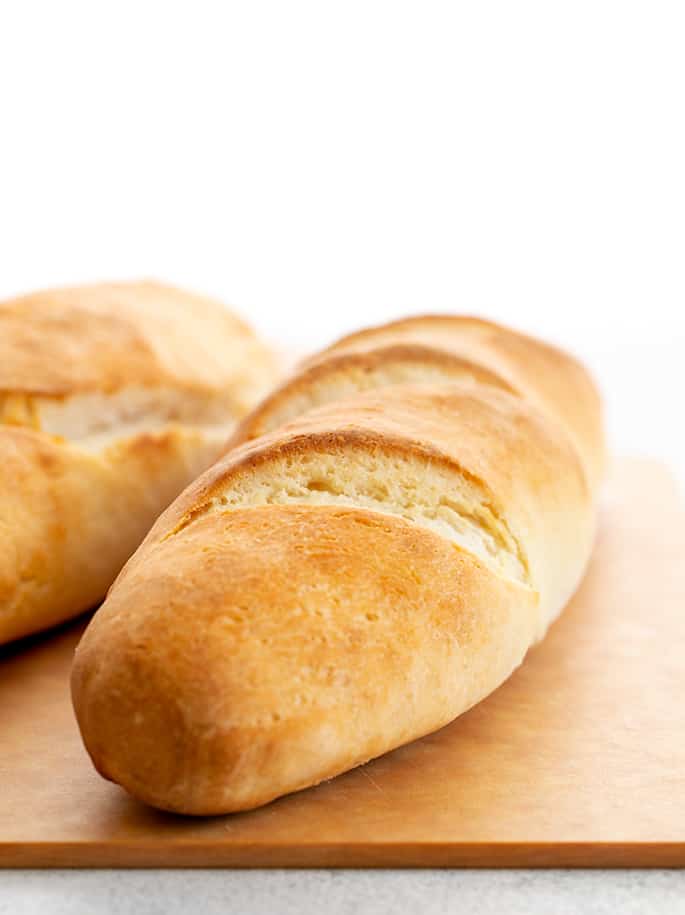
Tips for shaping and baking gluten free baguettes
When I use my gluten free bread flour blend to make baguettes, I shape them a bit differently, much like I do our Olive Garden style soft breadsticks. That involved patting and rolling the dough into a rectangle, folding both of the long sides toward the center, then doubling the rectangle on itself. That's a classic way to create a baguette shape.
This recipe is made using one of my preferred all purpose gluten free flour blends (preferably, Better Batter), rather than bread flour. It isn't as similar to conventional gluten-containing bread dough, like our gluten free bread recipe for sandwiches, and it doesn't rise quite as readily. I find that when I use that other shaping method, there are more likely to be gaps in the bread after baking.
Here, I like to shape the dough by creating a cohesive piece of raw bread dough by pinching together any and all gaps in the dough, so they don't separate during rising and baking. Then, roll out the dough with the palms of your hands, so the dough is thicker in the center, and tapered toward the ends.
The best way to explain the shaping method is to watch the how-to video that is included in this post. But in case you aren't able to see that, I'd explain it in the following way:
Position the palms of both hands right next to one another on the top of the cylinder of dough. Roll the dough first away from your body and then back toward it as you move your hands in a half moon motion away from one another, toward the edges of the dough.
Baking gluten free baguettes
Have you ever seen those baguette pans, which look like side-by-side slings made of metal, with a million little perforations? You don't need one of those.
I actually used to have a baguette pan, but I can't find it. That means that I must have given it away because it always drove me crazy when I tried to store it in a cabinet in my non-industrial-sized kitchen. I'm not sorry it's gone.
Those pans are, indeed, useful because they allow circulation of air all around the bread as it bakes. That's part of what creates a thin but extra-crispy crust even on the bottom of the bread—and helps shape the bread properly. I've found that it's just not necessary with this recipe, though.
For the crispiest crust, it does help to create some steam in the oven at the very start of the baking process. It's easy to do by adding some ice cubes to the oven floor at the very start of baking, then quickly closing the door.
If you don't feel comfortable adding ice cubes to the floor of your oven, try spraying the baguettes liberally with cool water in a clean spray bottle. Do the spritz either the moment right before or right after you place the pan in the oven.

Getting this gluten free baguette dough to rise
When I originally started developing this recipe, I thought I'd have to use a very wet dough. That's typical of gluten free bread made with anything other than my gluten free bread flour blend.
But when I made it with a very high hydration ratio (that's something we talked about in detail in our recipe for NY-style gluten free pizza crust), the dough barely browned, wouldn't crisp well on the outside, and was super squishy almost no matter how much I baked it.
That's good news, though, since a less-wet dough is much easier to shape. It does take a little bit longer to rise, and requires a bit more yeast. But neither of those is much of a problem.
The consistency of this dough is best explained by describing what it's not. It's not stiff, but it's not fragile. You can and should shape it without adding much additional flour, and be sure to shape it with additional tapioca starch, not all purpose flour.
Rising gluten free yeast dough
As with all yeasted dough, rising is variable with the ambient environment in your kitchen (not outside, unless you're setting the dough to rise outside). In warmth and humidity, rising time is shorter. If the air is cool and dry, it will take longer.
Be sure the dough is covered with oiled plastic wrap securely, but not tightly. You want it to have space to rise, but not be fully exposed at all.
And don't expect a doubling of the dough with this old-school gluten free bread dough. Instead, it will rise to about 150% of its original size. It's considered overproofed when the rise begins to break through the surface of the dough.
It will begin to look pockmarked, like it has craters on the outside, and it will become quite fragile. Stop before it gets to that stage, or at least the minute you observe it. This is a relatively quick-rising dough, so be watchful.
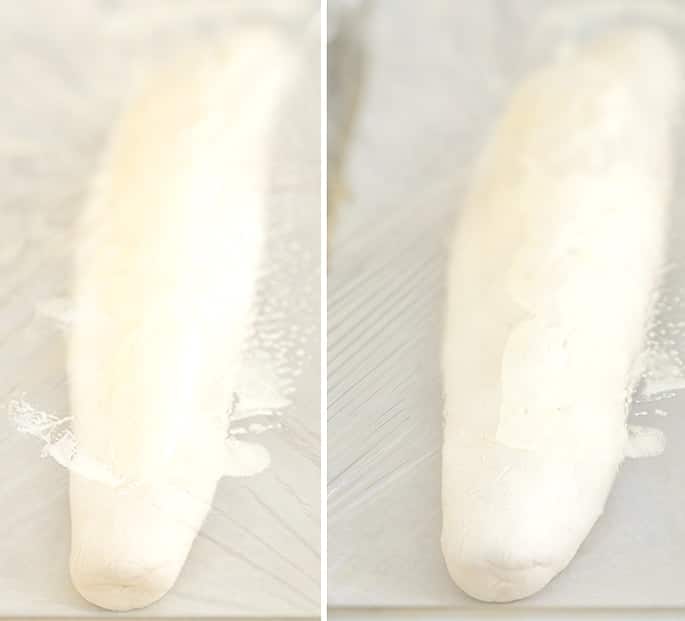
Ingredients and substitutions for these gluten free baguettes
Gluten free dairy free gluten free French bread
The only dairy in this recipe is the single tablespoon of butter. It can easily be replaced with Earth Balance buttery sticks, or (my favorite) vegan butters from either Melt or Miyoko’s Kitchen brand.
Gluten free egg free French bread
There is only one egg white in this recipe, and it helps provide structure. If you can’t have egg whites, you can try replacing the egg whites with an equal amount, by weight, of aquafaba, which is the brine from a can of chickpeas. Try beating the aquafaba until foamy with a whisk before adding it to the dough.
Can you make this gluten free French bread recipe without yeast?
No. You must use yeast in this recipe. There is no replacement, so if you can't have yeast, use the search function on the blog to search for “yeast free” bread recipes. They're completely different.
Instant yeast versus active dry yeast
Instant yeast is also called bread maker or rapid-rise yeast. If you only have active dry yeast, multiply the amount of instant yeast called for in the recipe (here, 6 grams) by 125%, and proof the yeast in about 1/4 cup of the water called for in the recipe before adding it to the dough.
Here, that would mean using about 7 1/2 grams grams of active dry yeast. Since most scales (mine included) aren't sensitive enough to measure 1/2 gram, just keep adding more yeast slowly after it reads 7 grams and stop approximately halfway to 8. Just do the best you can!
Gluten free Baguette FAQs
Yes! A baguette is a long, crusty loaf of bread that is French in origin. The terms gluten free French bread and gluten free baguette are used interchangeably!
Did you measure one of my recommended all purpose gluten free flour blends by weight? Did you make any ingredient substitutions? Did you add more than a small amount of gluten free flour to the dough during shaping? All of these could lead to a lack of a rise. Sometimes, though, your bread only needs a bit more time to rise.
Yes! These loaves of bread freeze really well. Let the loaves cool completely, slice them horizontally about 3/4 of the way through from side to the other (so the loaf stays together), and wrap them tightly in freezer safe plastic wrap. Freeze for up to 3 months. Defrost at room temperature.
Yes! If it's only a tiny bit stale, sprinkle it with lukewarm water all over. If it's very stale, run it under the tap. Then place the wet loaf on a parchment lined baking sheet and warm it in a 300°F oven for about 10 minutes. The excess moisture that isn't absorbed by the bread will bake off, leaving you with fresh-tasting, toasty gluten free baguettes!
Gluten Free French Bread
Equipment
Ingredients
- 1 ¾ cups (245 g) all purpose gluten free flour blend (I used Better Batter; please click thru for full info on appropriate blends)
- ¾ teaspoon xanthan gum omit if your blend already contains it
- ¼ cup (36 g) tapioca starch/flour plus more for sprinkling
- 2 teaspoons (6 g) instant yeast
- ½ teaspoon kosher salt
- ¾ cup (6 ounces) warm water (about 95°F)
- 1 (25 g (weighed out of shell)) egg white at room temperature
- 1 tablespoon (21 g) honey
- 1 teaspoon apple cider vinegar
- 1 tablespoon (14 g) unsalted butter at room temperature
- Cooking oil spray
Instructions
- In the bowl of a stand mixer fitted with the paddle attachment, place the flour, xanthan gum, tapioca starch/flour, and yeast, and whisk to combine well. Add the salt, and whisk again to combine.
- Create a well in the center of the dry ingredients and add the water, egg white, honey, vinegar, and butter, and mix to combine.
- Beat the mixture with the paddle attachment with the stand mixer on medium speed for about a minute. The dough will clump.
- Increase the speed to medium-high and continue to beat until the dough begins to stick to the sides of the mixing bowl and looks “whipped” in texture. Transfer the dough to a container with a lid that seals tightly, cover, and refrigerate for at least 30 minutes and up to 3 days.
- When you’re ready to shape the dough, turn the chilled dough out onto a flat surface lightly sprinkled with tapioca starch. Dust the top of the dough lightly with more tapioca starch, and turn it over a few times and knead it gently to smooth the dough.
- Using a large knife or bench scraper, divide the dough into 2 equal portions.
- Working with one piece of dough at a time, dusting very lightly with more flour as necessary to prevent sticking, shape the bread into a cylinder, pinching together any breaks in the dough to seal them.
- Position the palms of both hands right next to one another on the top of the cylinder of dough. Roll the dough first away from your body and then back toward it as you move your hands in a half moon motion away from one another, toward the edges of the dough.
- The shape should be thicker in the center, tapered toward the ends. See the video for a visual of shaping the dough.
- Place the shaped rolls a couple inches apart on a parchment lined baking sheet. Cover with lightly greased plastic wrap and place in a warm, draft-free environment and allow to rise until risen to about 150% of its original size.
- Rising will take longer in a dry, cool environment, and less time in a warm, humid environment. Do not place it in a heated oven, to any temperature, to rise, or you risk killing the yeast.
- As the bread dough is nearing the end of its rise, preheat your oven to 475°F and position the top rack a bit higher than the center of the oven. When the rise is complete, uncover the baking sheet.
- Using a small, sharp knife or a lame held at a 45° angle to the dough, slash each roll on top 3 times at evenly spaced spots on the dough about 1/4-inch deep. Spray the tops and sides of each roll liberally with cooking oil spray.
- Place the baking sheet on the top oven rack, toss a few ice cubes on the floor of the oven, and quickly close the oven door.
- Bake for 18 minutes, and rotate the baking sheet one half turn. Continue to bake for about another 5 minutes or until lightly golden brown all over and an instant read thermometer inserted into the thickest part of the roll read about 190°F.
- For a softer crust, wrap the hot rolls in a tea towel as they cool. Allow to cool for at least 10 minutes before serving.
WANT TO SAVE THIS RECIPE?
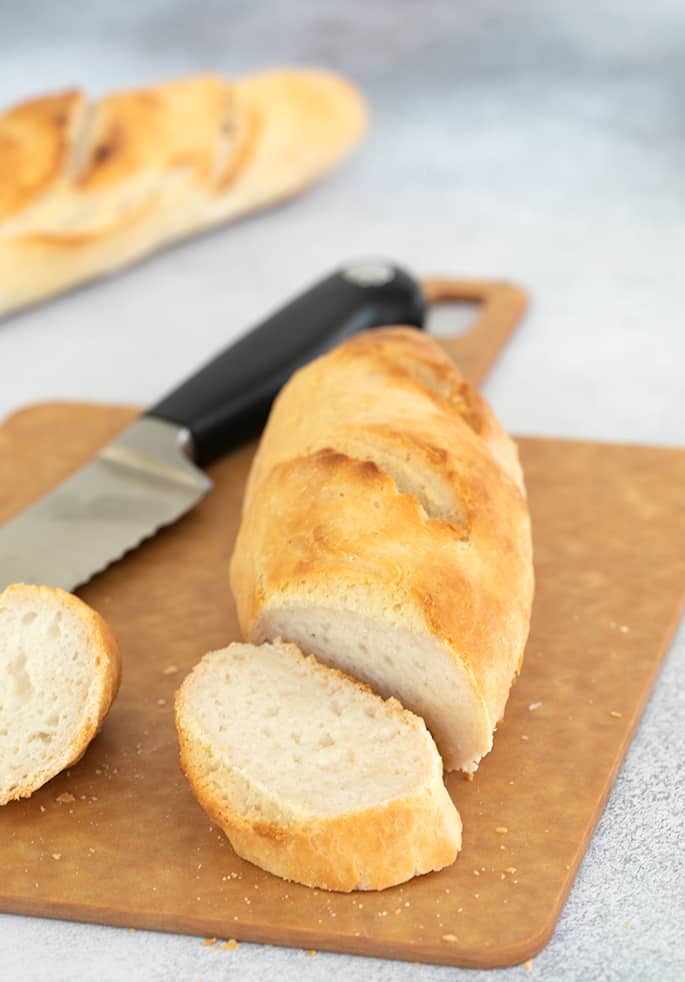
Gluten Free French Bread
Equipment
Ingredients
- 1 ¾ cups (245 g) all purpose gluten free flour blend (I used Better Batter; please click thru for full info on appropriate blends)
- ¾ teaspoon xanthan gum omit if your blend already contains it
- ¼ cup (36 g) tapioca starch/flour plus more for sprinkling
- 2 teaspoons (6 g) instant yeast
- ½ teaspoon kosher salt
- ¾ cup (6 ounces) warm water (about 95°F)
- 1 (25 g (weighed out of shell)) egg white at room temperature
- 1 tablespoon (21 g) honey
- 1 teaspoon apple cider vinegar
- 1 tablespoon (14 g) unsalted butter at room temperature
- Cooking oil spray
Instructions
- In the bowl of a stand mixer fitted with the paddle attachment, place the flour, xanthan gum, tapioca starch/flour, and yeast, and whisk to combine well. Add the salt, and whisk again to combine.
- Create a well in the center of the dry ingredients and add the water, egg white, honey, vinegar, and butter, and mix to combine.
- Beat the mixture with the paddle attachment with the stand mixer on medium speed for about a minute. The dough will clump.
- Increase the speed to medium-high and continue to beat until the dough begins to stick to the sides of the mixing bowl and looks “whipped” in texture. Transfer the dough to a container with a lid that seals tightly, cover, and refrigerate for at least 30 minutes and up to 3 days.
- When you’re ready to shape the dough, turn the chilled dough out onto a flat surface lightly sprinkled with tapioca starch. Dust the top of the dough lightly with more tapioca starch, and turn it over a few times and knead it gently to smooth the dough.
- Using a large knife or bench scraper, divide the dough into 2 equal portions.
- Working with one piece of dough at a time, dusting very lightly with more flour as necessary to prevent sticking, shape the bread into a cylinder, pinching together any breaks in the dough to seal them.
- Position the palms of both hands right next to one another on the top of the cylinder of dough. Roll the dough first away from your body and then back toward it as you move your hands in a half moon motion away from one another, toward the edges of the dough.
- The shape should be thicker in the center, tapered toward the ends. See the video for a visual of shaping the dough.
- Place the shaped rolls a couple inches apart on a parchment lined baking sheet. Cover with lightly greased plastic wrap and place in a warm, draft-free environment and allow to rise until risen to about 150% of its original size.
- Rising will take longer in a dry, cool environment, and less time in a warm, humid environment. Do not place it in a heated oven, to any temperature, to rise, or you risk killing the yeast.
- As the bread dough is nearing the end of its rise, preheat your oven to 475°F and position the top rack a bit higher than the center of the oven. When the rise is complete, uncover the baking sheet.
- Using a small, sharp knife or a lame held at a 45° angle to the dough, slash each roll on top 3 times at evenly spaced spots on the dough about 1/4-inch deep. Spray the tops and sides of each roll liberally with cooking oil spray.
- Place the baking sheet on the top oven rack, toss a few ice cubes on the floor of the oven, and quickly close the oven door.
- Bake for 18 minutes, and rotate the baking sheet one half turn. Continue to bake for about another 5 minutes or until lightly golden brown all over and an instant read thermometer inserted into the thickest part of the roll read about 190°F.
- For a softer crust, wrap the hot rolls in a tea towel as they cool. Allow to cool for at least 10 minutes before serving.
WANT TO SAVE THIS RECIPE?

Thanks for stopping by!
Hi, I’m Nicole. I create gluten free recipes that really work and taste as good as you remember. No more making separate meals when someone is GF, or buying packaged foods that aren’t good enough to justify the price. At Gluten Free on a Shoestring, “good, for gluten free” just isn’t good enough! Come visit my bio!


Danielle says
Hello! I followed exactly, amounts, brands etc, and it turned out a bit runny – the dough – can I add more flour until it’s more of a dough consistency, help! Thanks!
Nicole Hunn says
Please watch the how-to video, Danielle. If you didn’t make any substitutes (especially the flour blend!), and you measured by weight, then it might be the proper texture. Please watch the video (if you don’t see a video, you have to turn off your ad blocker, which I beg you not to use anyway), and read through the text of the post for tips about texture.
Susan says
Hi Nicole,
I made this today using Organic Namaste Perfect Blend Gluten Free Flour with great success. I did not add xanthan gum, and possibly used regular yeast as that’s all they had at Wholefoods. It has been years since I attempted making bread and am so excited to now have an organic gluten free option. I ate half a loaf by myself just to make sure I wasn’t dreaming. Thank you for this easy and delicious recipe. I may be brave enough to make more loaves for my daughter’s upcoming wedding party.
Nicole Hunn says
Hi, Susan, I’m really glad you’re happy with your results, but I really (really) do not recommend (for your benefit and others’ reading this) using Namaste flour blends in my recipes that call for an all purpose gluten free flour. I would not count on it working frequently, and certainly not consistently. Sorry!
Shannon says
Just made this for the first time and they turned out beautifully and tasty! I used Bob’s red mill 1 to 1 flour and had no issues, I just omitted the additional xantham gum as the recipe indicated and it went very smoothly. Will definitely be making these baguettes again
Nicole Hunn says
I’m glad you were happy with your results, Shannon. For others’ benefit, Bob’s Red Mill flour blends do not work in my recipes. It’s not a well-balanced, high quality flour blend.
Judy says
Making gf French baguette today. How long should I let it rise. I was thinking 45 minutes. Is that enough time.
Nicole Hunn says
There is no set time, Judy. You have to let it rise until it’s about 150% of its original size, as described in the recipe. It is very environment dependent, as I explain in the post.
Shantel says
Hi- any substitute for tapioca starch??
Nicole Hunn says
Please see the Ingredients and substitutions section, Shantel.
sal migliara says
Hi
Can expandex tapioca starch be used in this recipe instead of plain tapioca starch?
Nicole Hunn says
Definitely not, Sal! They are completely separate ingredients and don’t function the same.
Rose says
Hi Nicole,
I have a question about the 1/4 cup of Tacpioca starch/flour. Is that a blend of the two, or is it a 1/4 cup of each?
Thank you
Nicole Hunn says
Tapioca starch is the same as tapioca flour, Rose! The two terms are used interchangeably!
Cindy Johnson says
I left a query yesterday on how long to beat the bread; please disregard. I read your discussion on gluten free flours and since I used Bobs Red Mill, that is probably the source of the trouble. Thanks anyway!
Cindy Johnson says
Nicole, about how long should the bread be mixed on the stand mixer? I ended up beating it on med-high for about 12 minutes and it never changed the way it looked at all, nor did it stick to the sides of the bowl. I have poured it into the airtight bowl and refrigerated it but its pretty loose. I am sure I measured the ingredients accurately. Waah!
Kat says
I made this today, my first try at GF bread of any kind. I did sub corn starch for tapioca flour as I didn’t have any, otherwise followed the recipe. I was nervous but it turned out so yummy! Rose beautifully, once baked it was crusty outside, soft chewy inside, can’t even tell its GF. However, the crust looks kind of almost wrinkly and a bit pale. Could this be due to the corn starch? Will make this again regardless, but just curious if I can fix it
Nicole Hunn says
Yup, that’s the cornstarch, Kat! It doesn’t have the stretchy qualities of tapioca starch, and really isn’t an appropriate substitute.
Deborah says
Made this today – mixed up the dough yesterday and then baked it today – excellent results
Nicole Hunn says
I’m so glad, Deborah! Thanks for letting me know. Now you can make garlic bread, if you like.?
Jessica says
Mmm. I’ve made these a couple times lately for banh mi. So good! My daughter and I love them!
Nicole Hunn says
They are perfect for banh mi, Jessica! Thanks for letting me know.
Caryn Hamilton says
Hi Nicole,
I generally use the King Arthur All Purpose GF Flour; it is readily available where I live. Do you know if it is a viable substitute for the Better Batter flour you use?
Nicole Hunn says
It isn’t, no, Caryn. I discuss the subject fully on my gluten free flour blends page.
Nathaly Saucier livano says
Hi Nicole…
As mentioned in my previous comment I just made these… I used your better batter mix (I needed to omit the pectin as I can’t find it where I live).. I made 1 big bread instead of 2 little ones…
After 1 hour I saw that my Dough was cracking on 1 side and the other have small points so I decided to put it in oven… Not sure if I left it too long to rise or too short as my bread came out very heavy and a little dense… I could smell a little the yeast (not sure if it is because I’m not use to eat bread anymore – used active dry yeast as per your indication 7.5 gr)… Can you help me to trouble shoot?
Nicole Hunn says
Hi, Nathaly, I’m afraid you can’t just omit the pectin and use the blend without it, and expect it to work as described. If you can’t find pectin, try making my Better Than Cup4Cup blend, which doesn’t contain pectin and for everything but my bread flour blend, is my favorite overall.
Liana says
Nicole, I’m not sure if you will be able to answer this but do you think I can use Schär gluten free flour? I live in Brazil and the best GF flour we can get is Schär’s. I compared the ingredients to Better Batter and it’s a bit different. Thank you in advance and thank you for this page, it’s my reference when I need a recipe!
Nicole Hunn says
Hi, Liana, I’m afraid I’ve never tried it, so I honestly don’t know. Generally, their products are really good, but I’m afraid I don’t know how their all purpose gluten free flour would work in my recipes. In any event, my all purpose gluten free flour blend recipes are something I offer precisely for someone outside the U.S. who can’t purchase one of my recommended blends. You have that resource, if nothing else.
Rebecca says
are the tapioca starch measurements different with ultratex 3 or expandex like in your other recipes? or would they be the same?
Nicole Hunn says
This recipe doesn’t call for modified tapioca starch, like Ultratex or Expandex, Rebecca. It calls for plain old boring regular tapioca starch. They are not at all the same and cannot be used interchangeably. You can only use regular tapioca starch in this recipe.